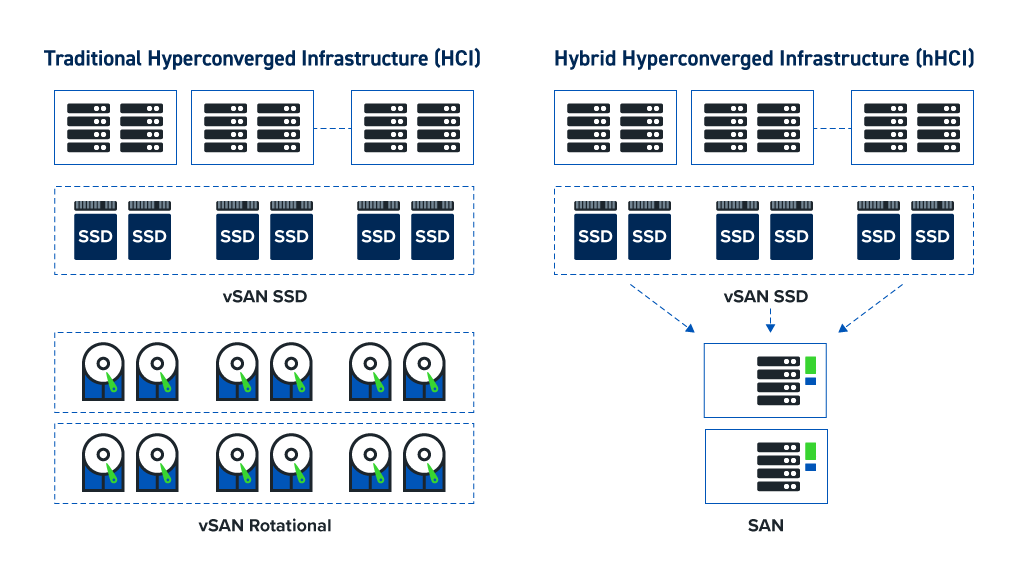As complex security threats have evolved, security technology has stayed one step ahead. Today, end customers across all verticals are deploying more smart sensors and intelligent video cameras than ever before—often outfitted with artificial intelligence (AI) to optimize threat detection and gain new business operations insights. However, as every IT professional knows, where there’s influxes in data, there will need to be an evolution in storage strategies.
For enterprises that need immediate, reliable and secure access to the data aggregated by their security system—especially those that capture massive amounts of video data—that need increasingly exceeds the parameters of traditional data infrastructure, often complicating IT and cost efficiency across the board. Around 2011, hyperconverged infrastructure (HCI) presented an exciting new model for data storage. Today, hybrid hyperconverged infrastructure (hHCI) addresses the limitations HCI created to better protect safety and security businesses from data loss and system idling.
Traditional Hyperconverged Infrastructure
For 10 years now, IT professionals have relied on HCI for its efficiency and simplicity. Because this software-defined IT infrastructure virtualizes all the elements of a conventionally “hardware defined” system (computing, storage, and networking), management of all resources can be shared across all instances of hyperconverged infrastructure, eliminating traditional data–center inefficiencies and reducing the total cost of ownership for all parties. In the security industry, this virtualization allowed multiple operators immediate and constant access to video data at any given time. It also offered a different avenue for protecting and storing data.
As with any IT innovation, however, a number of challenges accompanied this new infrastructure. Traditional HCI makes it difficult to increase compute and storage independently, for example, as the two are bound together at each node in a cluster. As a result, if an operation only needs more of one, scaling both in tandem not only drives up costs but also leaves one of the two in excess, leaving compute to idle or storage to go unused.
Even more worrisome, with traditional HCI, any node failure impacts the sustained I/O capabilities of the cluster, thereby reducing spindle counts and reducing performance capabilities during node rebuild. Because traditional HCI stores video data directly to the cluster itself, this can also lead to limitations in the overall processing capabilities and often requires an all Flash of SSD cluster to reach normative performance level.
Traditional HCI was a huge step in the right direction, especially for sensitive video data storage operations in the security industry. But these challenges beg a new approach.
Hybrid Hyperconverged Infrastructure: The Best of Both Worlds
Leaning on the strengths that HCI offered, such as instant access and IT efficiency, hHCI separates compute and storage from each other, in order to simplify independent scalability. In reality, storage and compute are almost always consumed asymmetrically. Whether a security system increases retention times or installs more security devices, storage is almost always consumed faster than compute. Because hHCI allows users to scale the two independently, this reduces hardware footprint, total cost of operations, and power requirements, while also ensuring faster disaster recovery and efficient, centralized system management.

BCD’s hHCI solution, REVOLV, powered by BCD’s Harmonize Software Suite, delivers a new and powerful option for companies who want to increase or scale one virtual hardware system without scaling another at the same time. REVOLV comes in three different solutions, DEEPSTOR Lite®, DEEPSTOR®, and DEEPSTOR+®—each built using servers from Dell, specialized switching from Alcatel-Lucent Enterprise, powerful SAN storage from DELL EMC, the latest hypervisor technology from VMware, and Intel® Xeon® Gold and Silver processors to ensure maximum computing performance.
When deciding between HCI and hHCI system designs, integrators and consultants should consider the unique requirements of their customer’s security ecosystem. With the growth of video data storage requirements, ensure your system is protected against data loss, system downtime, and uneven scalability with hHCI.

